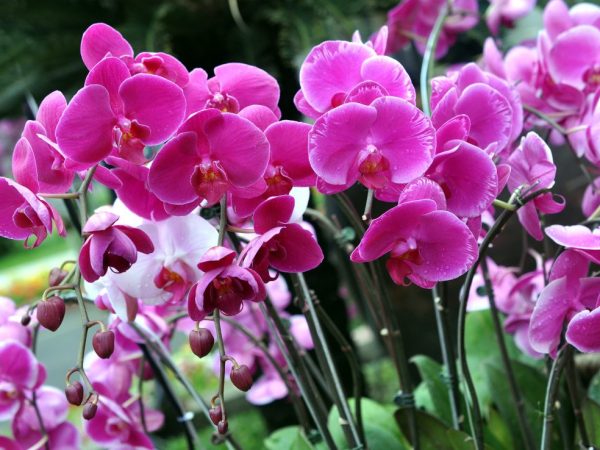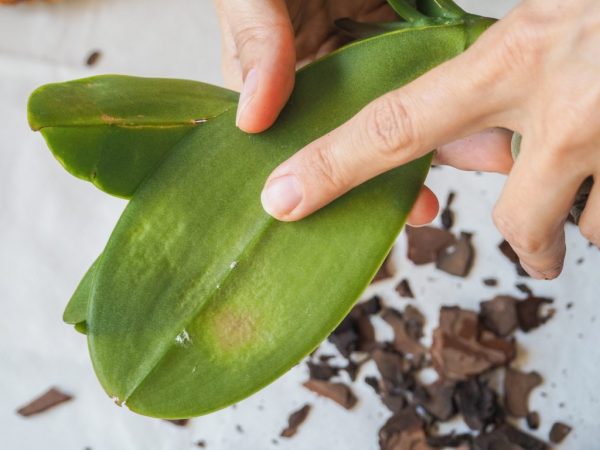Why Phalaenopsis lost tugor
Mistakes in the care of orchids lead to the appearance of painful symptoms. If you notice that phalaenopsis has lost turgor, it is necessary to timely determine the factors that led to such a state of green mass, and conduct appropriate treatment.

Why Phalaenopsis lost tugor
Reasons for loss of turgor
The main reason for the loss of turgor of the leaves of the Phalaenopsis orchid is improper care. But it is not worth sounding the alarm to the florist in advance. The appearance of 2-3 withered dry leaves is often a natural sign of flower rejuvenation. The old foliage gradually fades and is replaced by a new young green mass.
If most of the leaves are affected, the stem loses its density, the leaves become wrinkled and dry - the plant needs to be reanimated. We restore it depending on the factors that led to the lethargy of the foliage. They can be: problems with the root system, lack of moisture, mistakes in the choice of fertilizers, as well as diseases.
Root system problems
The condition of the roots of any plant is proportional to its health and developmental activity. That is, the entry of the root system into an unfavorable environment contributes to the deterioration of its appearance and condition. If the bush loses its normal appearance, the reason for this may be:
- Drying out of the roots. If the flower stands in direct sunlight or next to heating devices, the pet is threatened with overheating of the substrate. When the air temperature rises, the moisture contained in the soil evaporates more actively. And without noticing this in a timely manner, the florist deprives the orchid of nutrition.
- Lack of oxygen. This phenomenon is observed when the density of the soil changes. If it cakes and becomes heavy, oxygen availability decreases, which leads to the slow death of the flower. The wilting of foliage is evidence of this.
- Rotting roots. It is observed when water stagnates in a pot due to poor performance of the drainage system or its absence.
If the necessary conditions are created for the roots, the state of the indoor flower will gradually return to normal. The main thing to remember is that Orchids are epiphytic plants. Therefore, not only soil temperature and moisture are important, but also air quality.

The health and development activity of a flower depends on the condition of the roots of a flower.
Improper watering
If watering is frequent and plentiful, the flower suffers from the appearance of fungal microorganisms. He also suffers from a lack of moisture or the wrong way of introducing it. Such problems often arise in the summer, when, in the fight against high air temperatures, growers increase the amount of watering. This cannot be done.
The number of waterings cannot be increased. The flower's need for water should also be satisfied by spraying.
Improper feeding
If the orchid loses its turgor, the reason may be inaccuracies in the choice of fertilizer, as well as their application.The most common cases of problems with Orchid green mass are:
- Excess fertilizer dosage. Sign - the roots have changed their color.
- Use of unsuitable formulations. For Orchids, special mineral fertilizers are used. Nitrogen is required for foliage and root growth.
- Nutrient depletion. Often occurs after flowering. With the correct application of top dressing, the problem disappears.
Dry air
Insufficient air humidity often leads to wilting of Orchid leaves. Such a plant is epiphytic, therefore, high-quality care should be given not only to the roots, but also to the green mass of the flower.
The culture needs humidification, especially in summer. By neglecting the installation of a tray with water next to the pot, systematic spraying of foliage or wiping it, the processes of photosynthesis slow down.
Diseases
The appearance on the leaf blades of light or dark spots, small stripes and streaks are often signs of infection with Orchid diseases. The most dangerous are viral diseases. And the person himself is often guilty of this, who uses contaminated equipment when caring for a flower.
Usually, fungal diseases also occur due to the fault of the grower. Excessive watering, high air humidity and low temperature of the content become an ideal habitat for fungal microorganisms.

Viral diseases are most dangerous for orchids
Flower resuscitation
It will be possible to restore the turgor of Phalaenopsis leaves only after identifying the exact reason that caused such consequences. So, against diseases, the use of systemic fungicides or other drugs will be required. And in case of excessive or insufficient watering, the development of a soil moistening scheme and following it.
We restore problems with fertilizing by correct fertilization. If the pet is already overfed, you will need to rinse the roots with warm water and transplant the flower into a new soil. That is, by normalizing the care, it will be possible to return turgor to the foliage and create all conditions for the further growth of the pet.
Particular cases of loss of turgor
Some cases of foliage turgor loss require special attention, especially if such problems arose in flowering Phalaenopsis. This phenomenon occurs due to the weakness of the root system. She suffers from lack of moisture, underdeveloped or damaged. Flowering takes all the strength from the pet, so its green mass becomes sluggish. Such Phalaenopsis should be reanimated carefully so as not to affect the early wilting of flowers.
There are two ways to restore the foliage to its normal state. The first is plentiful watering of the flower with warm, settled water. The second is to immerse the pot in water with a minimum dose of potassium-phosphorus fertilizer for 1-2 hours. By choosing one of these methods and applying them, it will turn out to return the foliage of the indoor flower to the normal state.
If the orchid has lost its roots, it will be possible to restore the green mass by soaking the stem in water. After 3-4 days, the first shoots may appear. When they are detected, the plant is taken out of the water, placing it above its surface. When the shoots reach 4-5 cm, the flower should be planted in the ground.
Prevention of loss of turgor
Preventive measures for the wilting of plant foliage are aimed at organizing the correct care of the plant. It is necessary to take into account the peculiarities of the Phalaenopsis subspecies being grown and try to organize the most comfortable conditions for it. The florist should organize:
- Correct watering. Such a flower does not like overflows and reacts poorly to stagnant water in a pot.
- Top dressing. For the health of green mass, nitrogen fertilizers are necessary.
- Comfortable temperature and humidity.
The correct positioning of the flower pot is also important. Phalaenopsis do not like direct sunlight, so the windows on the north side will be the best place for them.It is also possible to place a pot with a pet on other windowsills, provided that it creates partial shade.
The flower feels comfortable in place, it will turn out to be recognized in a few days. If the shape of the leaves has become elongated, and they turn pale, the place is bad. If it is impossible to move Orchids, phytolamps with a natural spectrum of light will be required.
Conclusion
Regardless of the reason for the loss of turgor of the foliage of phalaenopsis, it will be possible to reanimate the plant with the timely detection of signs of wilting of the green mass. Treatment options are determined by the factors that lead to such consequences. With timely assistance, Phalaenopsis will return turgor to the foliage and continue to delight its owner with its growth and beautiful flowering.


